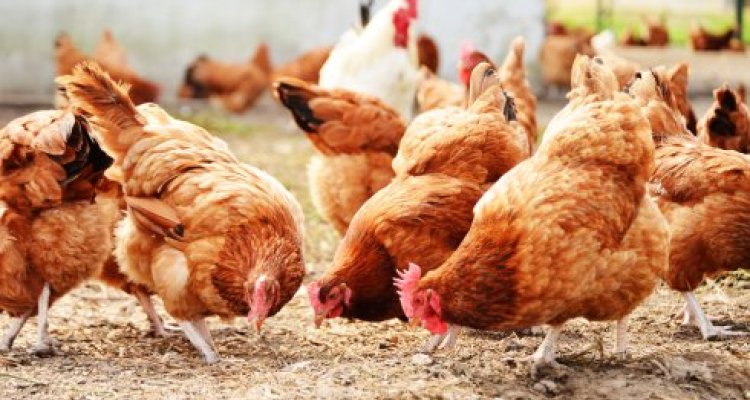
Press release
Video monitoring results at free-range poultry farm point at source of bird flu introductions
Continuous video-camera monitoring in the free-range facility of a poultry farm indicates regular visits by known carriers of bird flu viruses. The free-range layer farm experienced several different introductions of bird flu virus in the past 10 years.
A recent investigation by Wageningen Bioveterinary Research (WBVR) recorded visits of several different animal species. Mallards (wild ducks) visited the free-range facility of the poultry farm exclusively during the night between sunset and sunrise in the period November – April, with a peak frequency (bird numbers x days) in the period December – February. Several different gull species visited the free-range facility almost daily between sunrise and the time the chickens left the barn and entered the free-range facility in the morning in the period January – August.
Higher bird flu introduction risk
WBVR-research in the past years has shown free-range layer farms to be at higher risk of introduction of bird flu viruses. It is assumed that wild (water)birds are the source of these viruses on these poultry farms. After all, it would be logical for poultry to have direct contact with wild birds in the free-range facility or that poultry is exposed to water pools or soil in the free-range facility that is contaminated by faeces of wild birds.
Quantitative data on visits of wild birds to free-range facilities of poultry farms is necessary to develop and scientifically test intervention strategies to prevent or decrease contact between wild (water)birds and the free-range facility of poultry farms. However, such data are not available at present.
Video-camera monitoring
WBVR researchers, supported by students of Universities of Applied Sciences in Almere, Dronten, Velp and Delft, have investigated visits of wild fauna to the free-range facility of a poultry farm, assessed by video-camera monitoring. The layer farm with free-range facility experienced 6 separate introductions of different bird flu viruses since its start of production in 2008.
In total 8 digital video-cameras were installed to observe activities in the free-range facility 24 hr/day, 7 days/week and 12 months per year. Cameras were connected to a video-recorder, enabling storage of video recording. Cameras were equipped with infrared LEDs, enabling monitoring during the night. A total of 5,016 hours (209 days) of video recordings were analysed. A total of 24 different bird species and 7 species of mammals visited the free-range facility.
Epidemiologist Armin Elbers (WBVR), leader of the project: “Wild birds, with the exception of mallards, visited the free-range facility exclusively in the period between sunrise and the time the chickens entered the free-range area after leaving the barn in the morning. The moment the chickens entered the free-range area, the wild birds were hunted away by the chickens”.
The largest amount of exposure time of wild fauna to the free-range area was by far realized by the mallards and specifically in the period December – February. Only a small fraction of visits of wild fauna had overlap with presence of chickens at the same time in the free-range area. No direct contact between chickens and wild birds was observed.
Therefore, it is hypothesized that bird flu virus transmission to poultry on free-range poultry farms will predominantly take place via indirect contact: taking up virus by chickens via wild-bird-faeces-contaminated water or soil in the free-range area. The results of the study were recently published in the scientific journal Transboundary and Emerging Diseases.
Recommendations
The free-range poultry farmer has several possibilities to potentially lower the attractiveness of the free-range area for wild (bird)fauna:
- daily inspection of the free-range facility and removal of carcasses and eggs;
- prevention of forming of water pools in the free range facility.
Furthermore, it is recommended to discourage the start of new free-range poultry farms in AI high risk areas: areas that are close to waterways and nature-areas with waterfowl.
A large proportion of free-range poultry farms has never experienced a bird flu introduction. This is because they are likely to be located in areas with no or very limited exposure to wild water birds, like dabbling ducks. If a free-range poultry farm, with a history of repeated introductions of bird flu virus, is already located in a high-risk area, one can think about possibilities to scare away wild birds using trained dogs or laser equipment.
Another option to prevent contact between chickens and wild life, and at the same time fully address consumer demands with respect to welfare and an ecological way of production, is using other housing designs like the Rondeel concept. In this innovative chicken farm design, chickens have the possibility to be exposed to sunlight and fresh air in an outdoor area, but the outdoor area is totally fenced and together with the translucent but solid roofing offers shelter and protection, preventing contact with wildlife and their excrements in the environment.
Ministry of Agriculture, Nature and Food Quality
This study was funded and commissioned by the Netherlands’ Ministry of Agriculture, Nature and Food Quality (Veterinary Epidemiology and Risk Analysis project WOT-01-001-004).